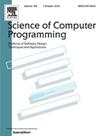使用过程代数的UML 2动态交互的交错语义和验证
IF 1.4
4区 计算机科学
Q3 COMPUTER SCIENCE, SOFTWARE ENGINEERING
引用次数: 0
摘要
UML序列图为系统中对象交互行为的建模提供了一种可视化的符号。由于UML语言的半形式化性质,它们缺乏精确的形式化语义,这阻碍了它们的自动化分析和验证。过程代数在文献中被广泛应用于处理这类问题。π微积分是一种著名的过程代数,具有丰富的理论基础和较高的表达能力。它还具有指定交错和弱排序的功能,OMG标准将其视为交互图的默认语义。因此,本文提出了一种将UML 2序列图转化为π微积分来形式化序列图的新方法。翻译抓住了它们基本元素的语义以及它们的组合片段。采用组合技术逐步建立相应的π-微积分规范,使元素易于归纳/递归,其意义便于对复杂的动态行为进行推理。后一项任务可以使用不同的分析工具来完成,例如本研究中使用的MWB工具。该映射根据OMG标准为UML2序列图提供了形式化的语义以及形式化的分析和验证。通过一个案例研究来说明翻译的有用性。本文章由计算机程序翻译,如有差异,请以英文原文为准。
Interleaving semantics and verification of UML 2 dynamic interactions using process algebra
UML sequence diagrams provide a visual notation for modeling the behavior of object interactions in systems. They lack precise formal semantics due to the semi-formal nature of the UML language which hinders their automated analysis and verification. Process algebras have been widely used in the literature in order to deal with such problems. π-calculus is a well-known process algebra recognized for its rich theoretical foundation and high expressivity power. It is also characterized by its capabilities in specifying interleaving and weak sequencing which is considered by the OMG standard as the default semantics for interaction diagrams. Thus, this paper presents a novel approach to formalizing UML 2 sequence diagrams by translating them into π-calculus. The translation captures the semantics of their basic elements as well as their combined fragments. A compositional technique is adopted to gradually build the corresponding π-calculus specification which results in easy induction/recursion of elements and their meaning enabling reasoning about complex dynamic behaviors. The latter task could be done using different analysis tools such as the MWB tool used in this study. The mapping provides a formal semantics as well as formal analysis and verification for UML2 sequence diagrams according to the OMG standard. A case study is shown to illustrate the usefulness of the translation.
求助全文
通过发布文献求助,成功后即可免费获取论文全文。
去求助
来源期刊

Science of Computer Programming
工程技术-计算机:软件工程
CiteScore
3.80
自引率
0.00%
发文量
76
审稿时长
67 days
期刊介绍:
Science of Computer Programming is dedicated to the distribution of research results in the areas of software systems development, use and maintenance, including the software aspects of hardware design.
The journal has a wide scope ranging from the many facets of methodological foundations to the details of technical issues andthe aspects of industrial practice.
The subjects of interest to SCP cover the entire spectrum of methods for the entire life cycle of software systems, including
• Requirements, specification, design, validation, verification, coding, testing, maintenance, metrics and renovation of software;
• Design, implementation and evaluation of programming languages;
• Programming environments, development tools, visualisation and animation;
• Management of the development process;
• Human factors in software, software for social interaction, software for social computing;
• Cyber physical systems, and software for the interaction between the physical and the machine;
• Software aspects of infrastructure services, system administration, and network management.
 求助内容:
求助内容: 应助结果提醒方式:
应助结果提醒方式:


